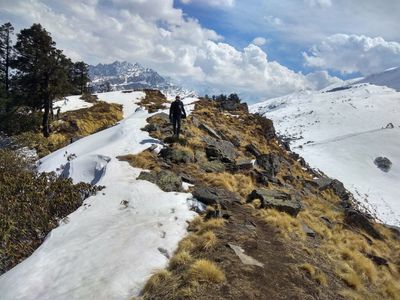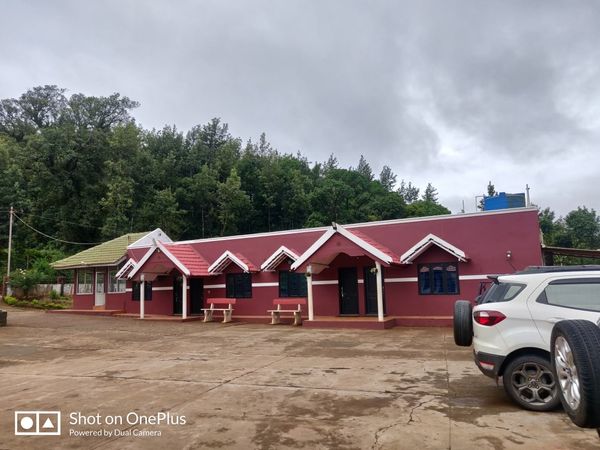Different Situations While Trekking to the Himalayas
 Rahul Singh
15 Feb, 2025
7 mins read
2
Rahul Singh
15 Feb, 2025
7 mins read
2

1. Unpredictable Weather Conditions
The Himalayas are notorious for their rapidly changing weather. Bright sunshine can turn into heavy snowfall within hours. Trekkers must always be prepared for sudden rain, chilling winds, and even blizzards. Wearing proper layered clothing and carrying waterproof gear is essential for survival in such conditions.
2. High-Altitude Sickness
As trekkers ascend beyond 2,500 meters, the oxygen levels drop significantly. Symptoms of altitude sickness include headaches, nausea, dizziness, and breathlessness. Acclimatization, hydration, and a slow ascent can help prevent serious health complications. If symptoms worsen, descending immediately is the best course of action.
3. Challenging Terrain and Steep Climbs
Himalayan treks involve diverse landscapes, from dense forests and rocky trails to glacier crossings. The steep climbs and rugged paths test the endurance of trekkers. Proper trekking boots, trekking poles, and physical fitness are crucial for handling these difficult terrains.
4. Encounters with Wildlife
The Himalayas are home to various wild animals, including Himalayan black bears, snow leopards, and mountain goats. While most animals avoid human interaction, it’s important to maintain a safe distance and avoid trekking alone, especially in dense forests.
5. River Crossings and Landslides
During monsoons, river levels rise, making crossings risky. Landslides are also common, blocking trails and making navigation difficult. Trekkers should check weather updates, follow the guidance of local guides, and use proper safety measures while crossing rivers.
6. Dealing with Exhaustion and Fatigue
Long trekking hours and continuous walking lead to fatigue. Proper rest, a balanced diet, and staying hydrated help in maintaining energy levels. Trekking at a steady pace and taking short breaks can prevent burnout and injuries.
7. Navigational Challenges and Getting Lost
Many Himalayan trails are unmarked, and losing the path is a real concern. Carrying a GPS device, map, and a compass is crucial for navigation. It is always safer to trek with experienced guides who are familiar with the terrain.
8. Limited Food and Water Supply
Finding food and clean water at high altitudes can be challenging. Carrying energy bars, dry fruits, and a water purification system ensures a steady supply of nutrition and hydration. Many trekkers rely on natural streams but must purify the water before drinking.
9. Camping and Survival in the Wild
Camping in the Himalayas requires skills like setting up a tent, making a fire, and handling extreme cold. Understanding the basics of wilderness survival is crucial. A good quality sleeping bag and insulated gear help in staying warm during freezing nights.
10. Popular Treks in the Himalayas
There are several breathtaking treks that offer diverse experiences in the Himalayas. Some of the most famous ones include:
- Kedarkantha Trek – A perfect winter trek with mesmerizing snow-covered landscapes.
- Chopta Chandrashila Trek – A scenic trek offering panoramic views of the Himalayas and Tungnath temple.
- Dodital Trek – A beautiful trek leading to a serene freshwater lake surrounded by dense forests.
- Deoban Trek – A short yet rewarding trek with stunning views of the Himalayan peaks.
- Warwan Valley Trek – A hidden gem in Kashmir with breathtaking landscapes and remote trails.
- Nafran Valley Trek – A mesmerizing trek through lush green meadows and pristine alpine lakes.
- Phulara Ridge Trek – A unique ridge trek with a continuous view of the Himalayan ranges.
- Gaumukh Tapovan Trek – A spiritual trek leading to the source of the Ganges River.
- Valley of Flowers Trek – A vibrant trek showcasing a breathtaking variety of wildflowers.
- Brahmatal Trek – A beautiful trek with serene frozen lakes and panoramic mountain views.
11. The Rewarding Experience of the Trek
Despite all the challenges, trekking in the Himalayas is an unforgettable experience. The stunning landscapes, mesmerizing sunrises, and the sense of accomplishment make every hardship worthwhile. Every trekker returns with a newfound appreciation for nature and personal endurance.
Whether you are a beginner or an experienced trekker, the Himalayas promise an unparalleled trekking experience.
Book your Himalayan trek today and embark on the adventure of a lifetime!
Written By:
Rahul Singh



Hotels at your convenience
Now choose your stay according to your preference. From finding a place for your dream destination or a mere weekend getaway to business accommodations or brief stay, we have got you covered. Explore hotels as per your mood.





